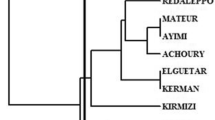Abstract
The fruit of Vitellaria paradoxa is an ideal raw material in cosmetic, pharmaceutical and confectionery industries. There are no accurate data on annual fruit yield due to the lack of objective assessment tools. The objectives of this study were to develop fruit yield prediction models based on dendrometric and fruiting variables, to examine variations in these variables between upland and lowland populations in Burkina Faso, and associations between these variables. A total of 191 fruiting trees were selected according to crown accessibility, and 17 dendrometric and fruiting variables were recorded. The fruit yield, expressed in number of fruits per tree, fresh and dry weights of fruits, was assessed by collecting fruits dropped overnight until the end of the fruiting period. Fruit yield prediction models were derived for each population using partial least squares regression. The results showed significant differences in dendrometric and fruiting variables between populations (P < 0.01). The lowland population had the highest values for most of the dendrometric variables while fruiting variables were the highest for the upland population. A strong significant correlation (P < 0.01) was found between number of shoots and fruiting variables. Within individual trees, fruit yield was lowest for the bottom part of the crown and the section of the crown with north-east orientation. Fruit yield parameters were successfully predicted based on selected dendrometric and fruiting variables (prediction error = 0.092 and 0.125 for upland and lowland populations, respectively). All fruiting variables, number of shoots and crown attributes had the highest influence on the models.
Similar content being viewed by others
References
Awasthi RP, Sharma SK (2001) Studies on apple yield forecasting on the basis of flowering, fruit set and tree biometrical parameters. Indian J Horticulture 58:309–313
Bharati RC, Khatri TJ, Parikh RK (1999) Pre-harvest forecast models for Mango (Var. Kesar) yield using weather variables. Gau Res J 24:79–83
Bayala J (2002) Tree crown pruning as a management tool to enhance the productivity of parklands in west Africa. Ph.D thesis, School of Agricultural and Forest Sciences, University of Wales, Bangor, United Kingdom, 207 pp
Boffa JMJ (2000) West Africain agroforestry parklands: keys to conservation and sustainable management. Unasylva 51:11–17
Devineau JL, Fournier A, Kaloga B (1997) Les sols et la végétation de la région de Bondoukuy (Ouest Burkinabè). Présentation générale et cartographie préliminaire par télédétection satellitaire (SPOT), ORSTOM, Paris, France, 117 pp
Eriksson L, Johansson E, Wold NK, Wold S (1999) Introduction to Multi- and megavariate data analysis using projection methods (PCA & PLS). Umetrics AB, Umeå, Sweden
European Union (2002) West Africa agro-business sector meeting. Strategic evaluation of the agro-industrial sector- BURKINA FASO. Consultant report, 8 pp
FAO (1986) Brise-vent et rideaux abris avec référence particulière aux zones sèches. Cahier FAO Conservation 15, Rome, Italie, 385 pp
Hall JB, Aebischer DP, Tomlinson HF, Amaning EO, Hindle JR (1996) Vitellaria paradoxa, a monograph. School of Agricultural and Forest Sciences, University of Wales, Bangor, UK, 105 pp
Kumar DP, Udupa KS (1996) The association between nut yield and yield attributing characters in cashew (Anacardium occidentale L.). THE CASHEW, Cochin, India, pp 11–17
Lamien N (2001) Organisation structurale et état sanitaire des populations fructifères de karité (Vitellaria paradoxa Gaertn.) de la région de Bondoukuy, Burkina Faso. Mémoire de DEA en Biologie et Ecologie Végétales, Université de Ouagadougou, Burkina Faso, 70 pp
Lorano-Gonzalez R, Storey BJ, Harris MK (1992) Three-dimensional characterization of bearing Pecan tree. HortScience 27:1181–1183
Lovett PN, Haq N (2000) Evidence for anthropic selection of sheanut tree (Vitellaria paradoxa). Agroforest Syst 48:273–289
Maranz S, Kpikpi W, Wiesman Z, Sauveur ADS, Chapagain B (2004) Nutritional values and indigenous preferences for Shea fruits (Vitellaria paradoxa C.F. Gaertn. F.) in African agroforestry parklands. Econ Bot 58:588–600
Martens H, Næs T (1989) Multivariate calibration. John Wiley & Sons Ltd, New York, 419 pp
Millogo-Rasolodimby J (1989) Importance apicole du karité, Butyrospermum paradoxum (Gaertn. Hepper) et du néré, Parkia biglobosa (Jacq. Benth.). Rev Franç Api 482:72–74
Næs T, Isaksson T, Fearn T, Davies T (2002) A user-friendly guide to multivariate calibration and classification. NIR Publications, Chichester, UK, 344 pp
Okullo JBL, Obua J, Okello G (2004) Use of indigenous knowledge in predicting fruit production of shea butter tree in agroforestry parklands of north-eastern Uganda. Uganda J Agri Sci 9:360–366
Plenderleith K, Brown N (2000) Baillonella toxisperma: a state of knowledge study. Oxford Forestry Institute, Department of Plant Sciences, Oxford University, Oxford
Prunet JP, Ginibre T (2001) Methods of forecasting walnut yield. Acta Horticultura 565–572
Schreckenberg K (1996) Forests, fields and markets: a study of indigenous tree products in woody savannas of the Bassila region, Benin. Ph.D. thesis, University of London, United Kingdom, 326 pp
Stajnko D, Lakota M (2001) Using image processing and analysis techniques for counting apple fruits in the orchard. Hort Sci 28:95–99
Teklehaimanot Z (2004) Exploiting the potential of indigenous agroforestry trees: Parkia biglobosa and Vitellaria paradoxa in sub-Saharan Africa. Agroforest Syst 61: 207–220
Tibshraeny C, Theron KI, Rabe E (1997) Yield estimation of mandarin trees by the “Bavendorf” and frame count methods. J S Afr Soc Hort Sci 7: 20–22
Winter F (1988) Method and results of the “Bavendorf apple forecast model” as introduced in 1987 in Santa Catarina (Bresil). Acta Hort 232:235–244
Acknowledgements
We would like to express our thanks to Swedish International Development Agency (Sida), the Centre National de la Recherche Scientifique et Technologique (CNRST) and the University of Ouagadougou of Burkina Faso for funding this study through a collaborative program. Colleagues are acknowledged for valuable discussion.
Author information
Authors and Affiliations
Corresponding author
Rights and permissions
About this article
Cite this article
Lamien, N., Tigabu, M., Guinko, S. et al. Variations in dendrometric and fruiting characters of Vitellaria paradoxa populations and multivariate models for estimation of fruit yield. Agroforest Syst 69, 1–11 (2007). https://doi.org/10.1007/s10457-006-9013-x
Received:
Accepted:
Published:
Issue Date:
DOI: https://doi.org/10.1007/s10457-006-9013-x




